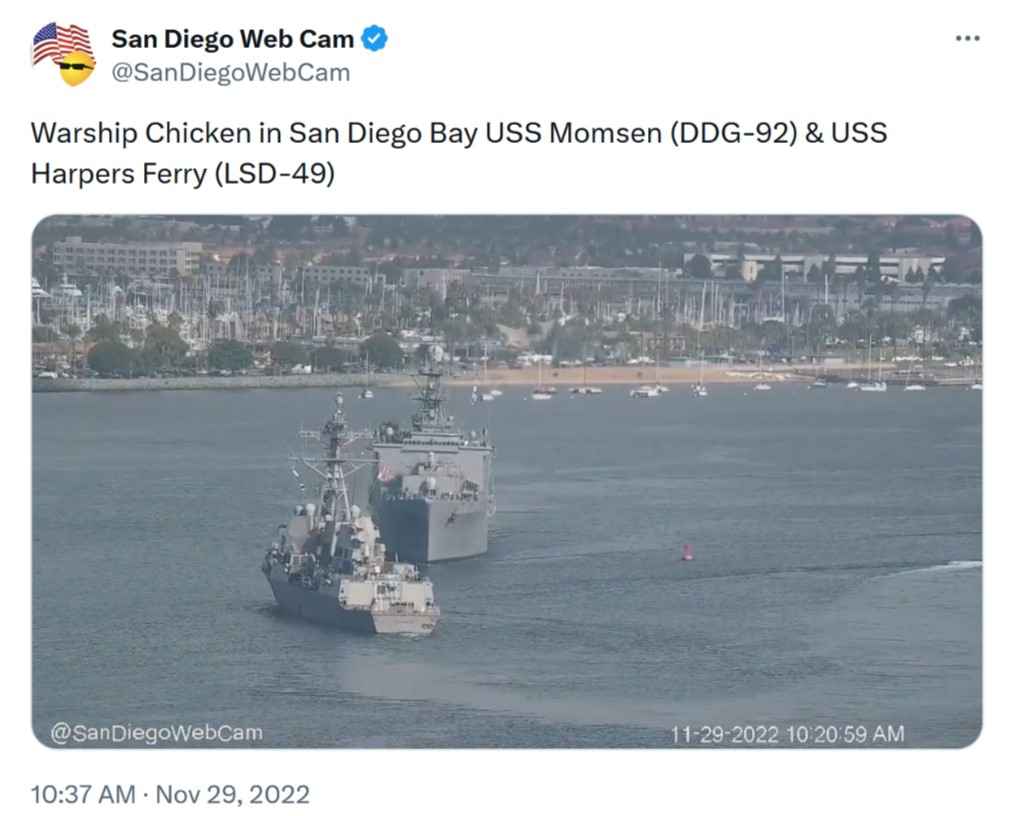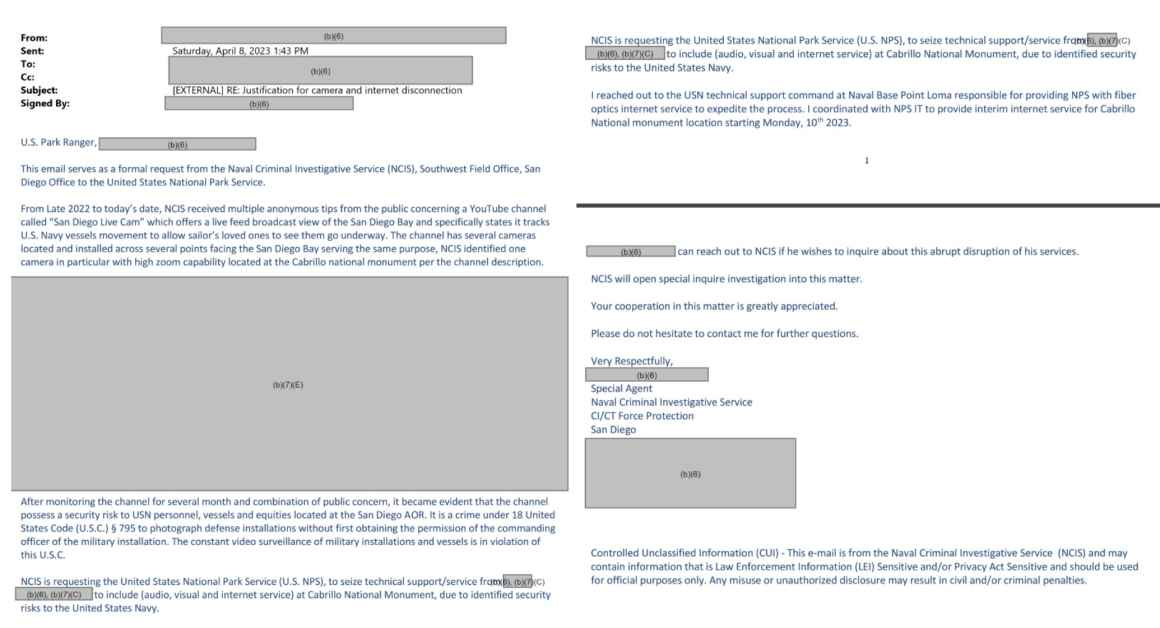Boats, the Bay and Big Government: The Fight Over San Diego’s Webcams
by Mohammad Tajsar, Senior Staff Attorney at the ACLU of Southern California
If the government yells “national security” in the middle of the harbor, will anyone hear it?
Since the September 11 attacks, one of the ACLU’s least favorite pastimes has been challenging the government’s naked assertions of “security” to justify restrictions on people’s freedoms. Whether claiming “national security” prevents Muslims from challenging the government for spying on their mosques or that “national security” prevents journalists and advocates from getting access to public records about the government’s business, the government has a long history of crying “security” as a way of trampling on people’s rights in transparent attempts to conceal its own misdeeds. Since last year, the Navy to have taken this troubling pattern to absurd new heights, all because of some YouTube videos of San Diego Bay.
San Diego Web Cam (@SanDiegoWebCam) is a small YouTube operation with just over 53,000 followers. It operates six live cameras positioned all around the San Diego Bay, a 12-mile natural harbor and port that abuts the cities of San Diego, Chula Vista, Imperial Beach, Coronado and National City.
San Diego Web Cam is a passion project of its owner and operator, Barry Bahrami, an IT professional and local San Diegan who grew up around the bay. He works with local businesses, residents and government officials to find interesting vantage points to install these cameras, allowing online viewers to catch a live glimpse of San Diego Bay.

Figure 1: Screenshot of San Diego Web Cam's YouTube page.
The webcam setups are expensive systems that include the cameras, hardware that connects the cameras to the internet and mechanisms to mount them to a building or roof. Once installed, the cameras capture beautiful vistas of the bay—views that locals and visitors of “America’s Finest City” see every day from the public streets, sidewalks, business districts and parks that surround it.
At one point, San Diego Web Cam operated a camera on the grounds of Cabrillo National Monument, a federally owned public park maintained by the National Park Service. This monument sits upon a pristine perch with views of the entire bay, including a naval base, that thousands of parkgoers enjoy every month.
The ability to tune in from the comfort of your own home has proven popular among many, including some military families. These families log on to watch their loved ones’ military vessels travel in and out of the Naval Base San Diego, Naval Air Station North Island and other naval installations located in the bay. “Having those cameras and having that access you feel like you're there even though you're not there,” the mother of a deployed Naval servicemember told a local news outlet. Military and maritime enthusiasts also are regular viewers of the cameras, which capture new and old vessels alike in the bay’s water.
At any given time, the webcams attract anywhere from a dozen to a few hundred viewers. However, on rare occasions, the cameras’ footage has gone viral—apparently to the chagrin of the U.S. Navy. In November 2022, San Diego Web Cam captured two Navy ships nearly colliding with each other in San Diego Bay, an incident that drew public outcry. A Navy investigation found serious operational errors that resulted in the near-miss. San Diego Web Cam posted footage of the incident on X with the caption “Warship Chicken.”

Figure 2: Tweet from San Diego Web Cam showing video of Naval near-miss.
In April 2023, the same month the investigation’s results leaked to the public, Navy investigators sent an email to the National Park Service alleging that the camera at Cabrillo National Monument is “a security risk to [U.S. Navy] personnel, vessels and equities.”i The Navy cited 18 U.S.C. 795, a federal law that prohibits photographing or drawing certain “vital military and naval installations or equipment,” and said that the web cameras’ “constant video surveillance of military installations and vessels [is] in violation” of this law. Within days, the park service shut down the Cabrillo National Monument camera.

Seven months later, on November 7, 2023, the Navy suffered another embarrassment. This time, one of the San Diego Web Cam cameras caught footage of a retrofitted Navy destroyer with repairs that made the ship look “bug-eyed,” drawing mockery and ire from military observers and pockets of the internet. Just two days later, on November 9, the Navy contacted the Kona Kai Resort, a local hotel that hosted another one of San Diego Web Cam’s cameras, “urg[ing] the resort to, essentially, stop the show.”
The timing of these requests—coming soon after the Navy’s embarrassing incidents went viral—suggests that the government is none too pleased about these cameras documenting their otherwise public foibles, and it is flexing its muscles to try to shut them down. The problem, of course, is that the Constitution prohibits it from doing so.
The right to photograph matters of public interest within public spaces is long protected by the Constitution. The First Amendment prohibits the government from infringing on this right, even if—and especially if—the government itself is being photographed. This means that people have a strong right to photograph and record police officers arresting someone or a protest happening at an intersection or a government construction crew building a new bridge, as long as they’re doing so from somewhere they have a right to be (like a public street).
In San Diego Web Cam’s case, the First Amendment protects its ability to record and broadcast the beautiful waters of the bay—something any local or visitor would be able to see by strolling the parks, streets and shopping centers that surround it. The government cannot prevent anyone from recording these waters that are easily viewable to the public.
But what if the government claims that “national security” precludes the webcams from photographing or recording their naval bases from areas open to the public? Such a claim would miss the mark entirely. The ACLU previously brought cases challenging exactly this logic. One particularly noteworthy example involved activists who tried to photograph the border near San Diego. When they did, U.S. Customs and Border Protection officials intimidated and threatened the activists who were on public streets and prevented them from photographing their officers at the port of entry—including by confiscating a cellphone and forcibly deleting the photographs.
The ACLU of San Diego & Imperial Counties sued on behalf of these activists. In response, the government argued that even though the activists were on public property photographing border officers from vantage points accessible to any passerby, it nevertheless had the right to infringe on that right to protect “the extremely compelling interest of border security” and the “United States’s territorial sovereignty.” The case eventually reached the Ninth Circuit Court of Appeals, which ruled against these naked violations of First Amendment rights backed by empty assertions of national security. The court said such justifications are “too thin,” and that “general assertions of national security” are not enough to restrict “First Amendment activities in traditional public fora such as streets and sidewalks.”
The same applies to San Diego Web Cam. If any passerby can view the bug-eyed boats or maritime near-misses that got San Diego Web Cam in hot water, vague assertions of national security cannot force the webcam offline. It would be a different case if Mr. Bahrami set up his web cameras inside a restricted naval base, or used his cameras to somehow record military installations that cannot be seen from public areas—then the criminal statute that Naval Criminal Investigative Service (NCIS) cited to shut down the Cabrillo Monument Park camera, 18 U.S.C. 795, might apply. However, this law has no bearing prohibiting a web camera from live streaming something any local or visitor can see with their own eyes.
Given this First Amendment precedent, forcing San Diego Web Cam to shut down would be unconstitutional. Perhaps the government could simply ask nicely, as it may have done with the Kona Kai camera. Nothing prohibits the government from trying to persuade people, including either San Diego Web Cam or its partners, to act a particular way or stop saying a particular message. It has the right to speak just as much as an individual citizen does, but when that speech starts to morph into coercion, threats or outright demands, that’s when the Constitution steps in.
The government’s actions suggest that its own embarrassment—rather than any national security concern—is behind its attempts to have the cameras taken down. San Diego hosts 31.8 million visitors every year. A million of them visit Cabrillo National Monument annually. The Navy’s apparent attempt to shut down webcam footage of the harbor is a strategy about as effective as prohibiting cameras in Times Square—it is trying to shut down online content that millions of people can see with their own eyes. If the Navy actually coerced the park service or the owners of Kona Kai to shut down San Diego Web Cam, or if it thinks of doing this in the future, then it can rest assured that the ACLU will be on the case. As one Reddit user wrote, “Preventing people from filming ships in San Diego is like preventing people from filming the sun rise.” We agree.
